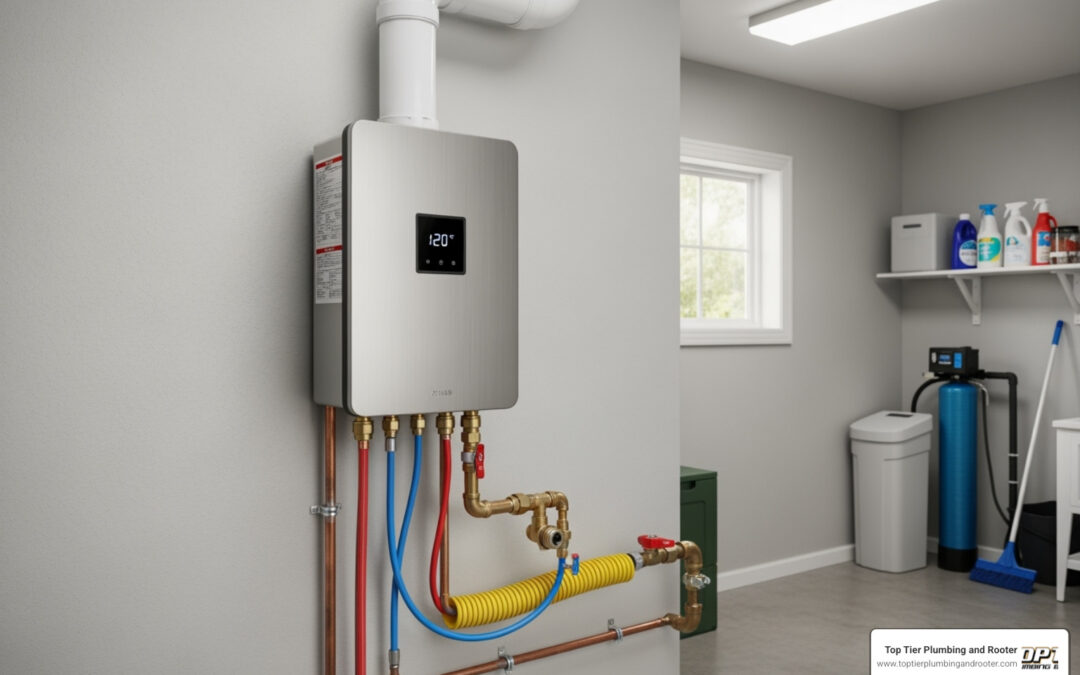Why Proper Tankless Water Heater Sizing Makes All the Difference
Tankless water heater sizing is the process of choosing the right capacity unit for your home. Get it right, and you’ll have endless hot water. Get it wrong, and you’ll face cold showers and wasted money.
Quick Sizing Guide:
- Flow Rate (GPM) – Add up all fixtures you’ll use at once
- Temperature Rise (ΔT) – Subtract incoming water temp from desired temp
- Household Size – More people = higher demand
- Climate – Colder areas need more heating power
Unlike traditional tank heaters that store a limited supply, tankless units heat water on demand. This means they must be sized to handle your household’s peak hot water usage all at once. The worst time to find a sizing mistake is mid-shower.
The good news is that proper sizing ensures you’ll never run out of hot water again. The challenge lies in understanding two key factors.
In Riverside and San Bernardino counties, where conditions vary, correct sizing prevents costly mistakes. An undersized unit delivers lukewarm water during peak use, while an oversized one wastes energy. The solution is simple: measure and calculate your home’s specific needs.
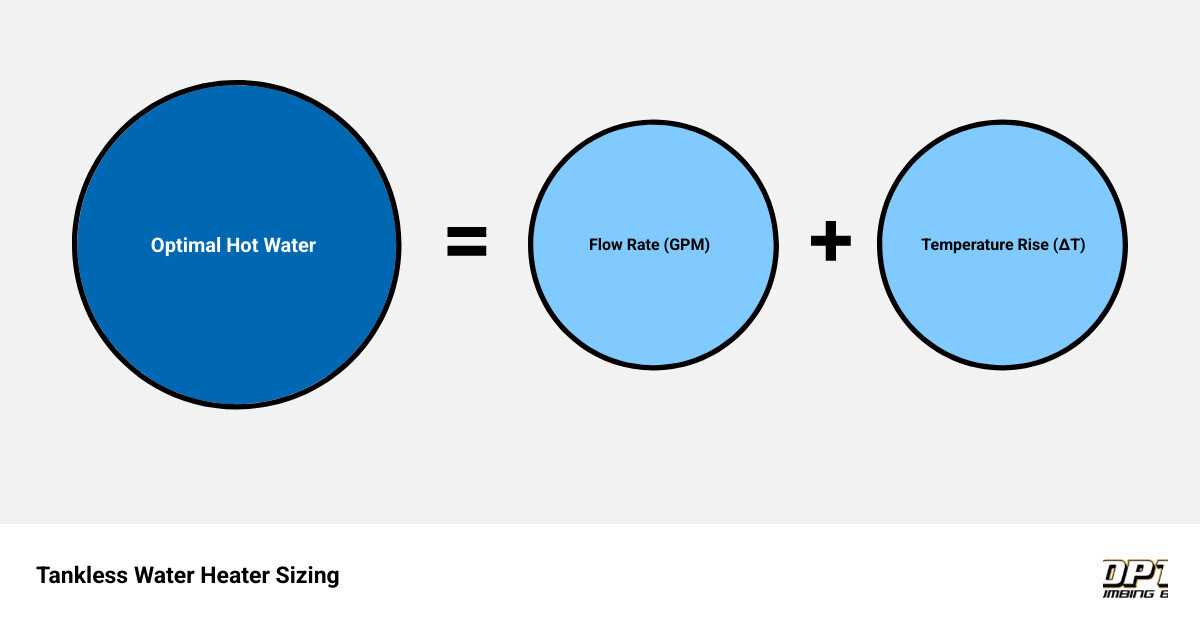
Must-know tankless water heater sizing terms:
The Two Pillars of Sizing: Flow Rate and Temperature Rise
Tankless water heater sizing depends on two key factors: flow rate and temperature rise. Think of it like planning a dinner party—you need to know how many guests are coming (flow rate) and how much cooking is required (temperature rise). Getting either wrong leads to disappointment. Once you understand these pillars, the sizing process becomes straightforward. The Energy Saver guide on sizing new water heaters provides additional insights into these principles.
Flow rate is how much hot water you need at once, while temperature rise is how hard the unit must work to heat it. Miss either calculation, and you risk lukewarm showers or a high energy bill.
Understanding Flow Rate (Gallons Per Minute)
Flow rate is the volume of hot water your fixtures use per minute, measured in gallons per minute (GPM). Sizing isn’t about total daily use, but the maximum amount needed at one time, like during a busy morning.
A tankless heater only cares about the fixtures you use simultaneously. If a shower, dishwasher, and kitchen sink are all running, your unit must supply enough GPM for all three. This peak demand moment determines your sizing needs. Identifying your household’s realistic maximum usage is critical for proper tankless water heater sizing.
The Importance of Temperature Rise (ΔT) and Your Location
Temperature rise (ΔT) is the difference between your incoming cold water temperature and your desired hot water temperature. The larger the difference, the harder your unit must work.
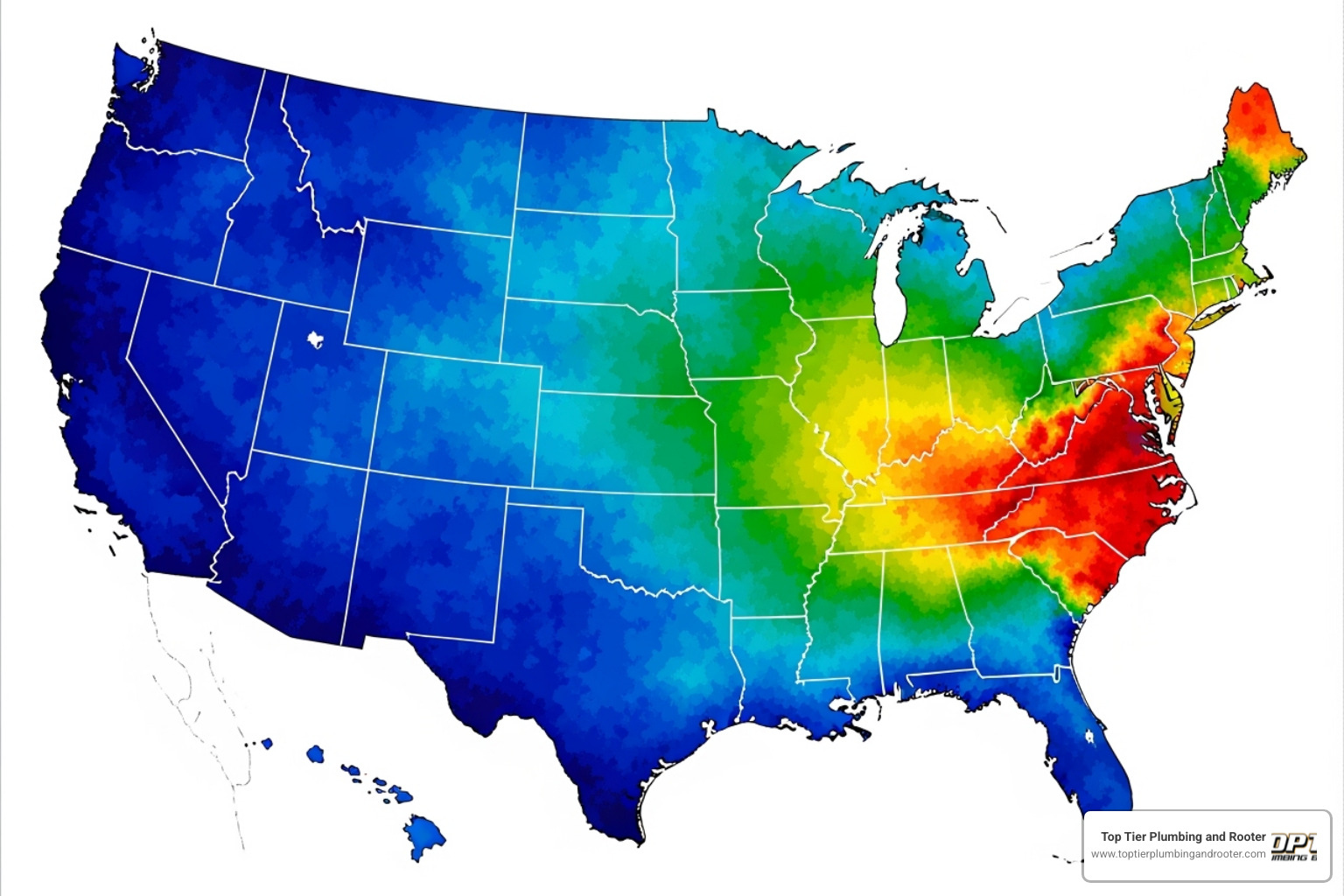
Living in San Bernardino County or Riverside County is an advantage, as our groundwater is warmer than in colder climates. Southern California’s groundwater is typically 55-70°F.
However, cold weather still impacts your system. If you want 120°F water and the incoming temperature drops from 60°F to 45°F in winter, your required temperature rise jumps from 60°F to 75°F. This increase could lead to lukewarm water if your unit isn’t sized for it.
Most homes aim for a desired output temperature of 120°F—hot enough for cleaning but safe from scalding. Understanding how local groundwater temperature affects this is essential for correct tankless water heater sizing.
A Step-by-Step Guide to Tankless Water Heater Sizing
Ready to tackle tankless water heater sizing? Breaking it down into steps makes the process straightforward. The key is to calculate your specific hot water demand based on your household size, number of bathrooms, and daily habits. We’ll walk you through it. If you’re still deciding between tank and tankless, our guide on The Pros and Cons of Traditional vs. Tankless Water Heaters in Riverside and San Bernardino County can help.
Step 1: Calculate Your Household’s Peak Hot Water Demand
First, identify the maximum amount of hot water your household might use at one time. This isn’t about total daily use, but how many fixtures might run simultaneously during your busiest hour. Think about your family’s routine: are showers, dishwashers, and laundry running at the same time? These overlapping moments define your “peak usage scenario” and are crucial for tankless water heater sizing.
Here are typical flow rates for common fixtures:
| Fixture | Typical Flow Rate (GPM) |
|---|---|
| Shower | 1.5 – 3.0 |
| Kitchen Faucet | 0.5 – 1.5 |
| Bathroom Faucet | 0.5 – 1.5 |
| Dishwasher | 1.0 – 2.5 |
| Washing Machine (Hot) | 1.0 – 3.0 |
| Bathtub | 4.0 – 6.0 |
For example, if one person is showering (2.5 GPM) while the dishwasher runs (1.0 GPM) and the washing machine is on a hot cycle (2.0 GPM), your peak demand is 5.5 GPM.
Family size is a major factor. Smaller households (1-2 people) may need 2-6 GPM, while larger families (4+ members) often require 6-10 GPM or more.
Step 2: Determine Your Required Temperature Rise
This calculation, or ΔT, tells your unit how hard it must work.
First, set your ideal hot water temperature. Most families find 120°F comfortable and safe. For dishwashers without an internal heater, 140°F might be needed, but 120°F is generally recommended for safety.
Next, find your incoming groundwater temperature. This varies by location and season. In Southern California, it fluctuates but is warmer than in northern states. To get a reading, run your cold water tap for a minute and use a thermometer.
Finally, do the math: Subtract the incoming water temperature from your desired temperature. If you want 120°F water and your incoming water is 50°F, your temperature rise (ΔT) is 70°F. If incoming water drops to 40°F in winter, your ΔT becomes 80°F, requiring more heating power.
Step 3: Putting It All Together for Your Home
With your peak GPM and required ΔT, you can find a unit that meets or exceeds your needs. Manufacturers provide charts showing GPM capacity at different temperature rises.
If you need 5.5 GPM with a 70°F temperature rise, choose a unit rated for at least that. Undersizing is the biggest mistake, leading to lukewarm water during peak demand. A slightly oversized unit is a safer bet.
Online sizing tools like NaviSizer are great starting points. However, they can’t account for unique plumbing or usage patterns. That’s why a professional consultation is invaluable to confirm your calculations and ensure your new heater will deliver the endless hot water you expect.
Key Factors: Gas vs. Electric, BTU, and Other Considerations
Beyond GPM and ΔT, other factors influence tankless water heater sizing, including fuel source, technology, and whether you’re replacing an old tank model. Understanding these elements ensures your new system delivers on its promises. For a deeper look at the benefits, see The Advantages of Upgrading to a Tankless Water Heater.
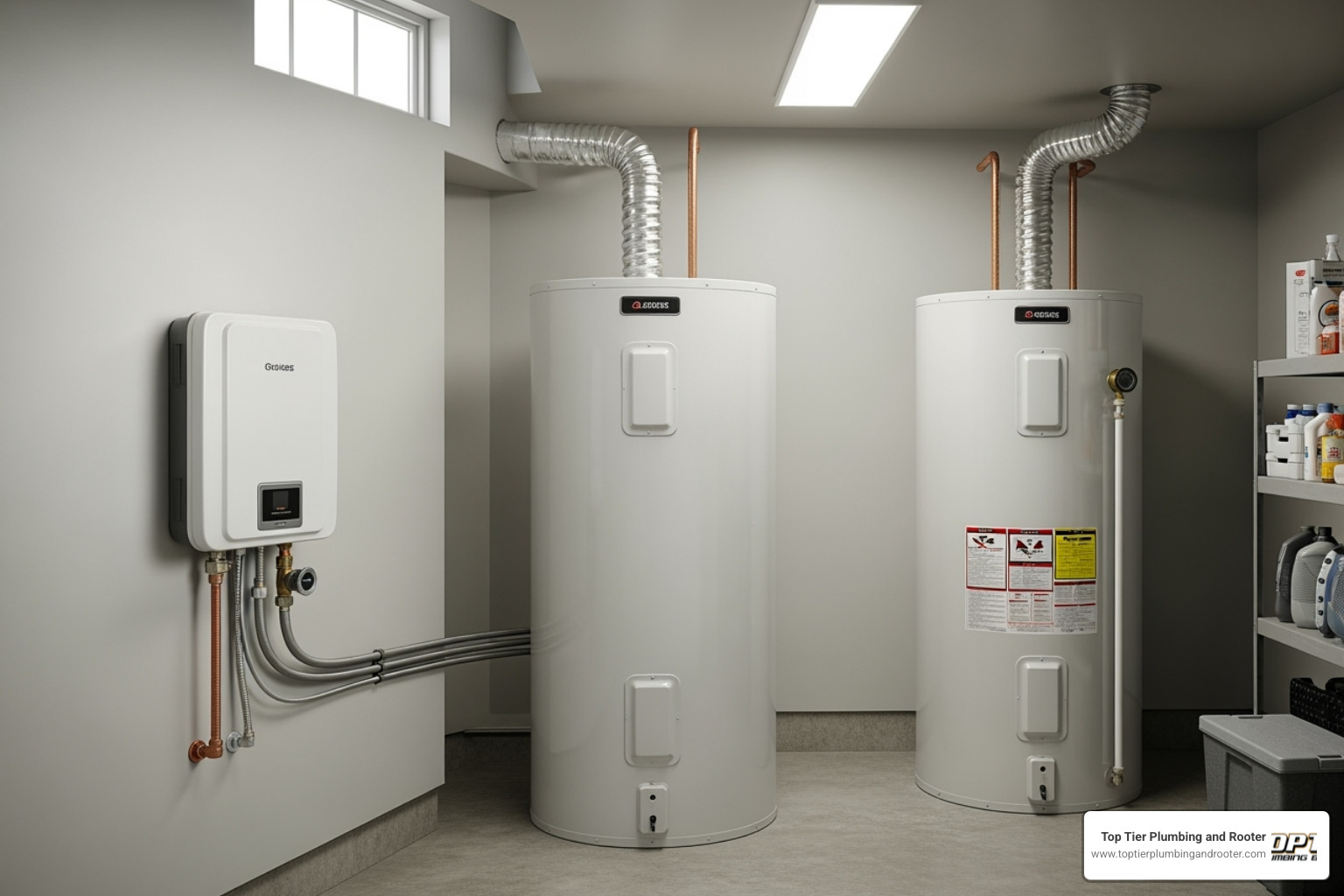
Gas vs. Electric: Sizing and Performance Differences
The fuel type you choose dramatically affects performance and sizing.
Gas tankless water heaters are the powerhouses, delivering higher GPM outputs at significant temperature rises. This makes them ideal for larger homes and families. Their heating power is rated in BTUs (British Thermal Units)—more BTUs mean more heating capacity and higher flow rates. A larger home might need a unit with around 380,000 BTUs. However, gas units require a gas line and proper venting, making installation more complex.
Electric tankless water heaters are compact and highly efficient (around 98%). They are easier to install as they don’t need venting or gas lines. Their drawback is lower power output, making them better suited for smaller homes, apartments, or point-of-use applications. A major consideration is that they often require significant electrical panel upgrades to handle their power demands.
Condensing vs. Non-Condensing Technology
This distinction, primarily for gas units, affects efficiency and venting.
Non-condensing units are simpler and heat water by sending hot exhaust directly outside through stainless steel vents. This design is less expensive upfront but loses some heat energy in the process.
Condensing units are more advanced. They capture heat from the exhaust gases to pre-warm incoming water, boosting efficiency to 90% or more. Because the exhaust is cooler, they can often be vented with less expensive PVC pipes. This technology allows you to achieve the same performance with less fuel, influencing which size unit is best for your home.
Replacing a Traditional Tank: Special Sizing Considerations
Switching from a tank to a tankless model requires a new way of thinking. A traditional tank is sized by its storage capacity (e.g., 50 gallons) and its First Hour Rating (FHR).
Tankless units are sized by production capacity (GPM), not storage. It’s the difference between a bucket of hot water and a faucet that creates it instantly. This transition often requires plumbing upgrades. Gas tankless units may need larger gas lines, while electric models can demand major electrical service upgrades. Venting requirements also differ from traditional heaters.
The reward is replacing a bulky tank with a compact, wall-mounted unit, freeing up floor space and providing endless hot water. If you’re deciding whether to upgrade or repair, our guide Should You Replace or Repair Your Water Heater? can help.
The Payoff: Benefits of Proper Sizing & Risks of Getting It Wrong
The effort you put into proper tankless water heater sizing pays off in ways you’ll notice every single day. Think of it like buying the right size shoes—get it right, and you’ll walk comfortably for years. Get it wrong, and you’ll be reminded of your mistake every time you take a step.
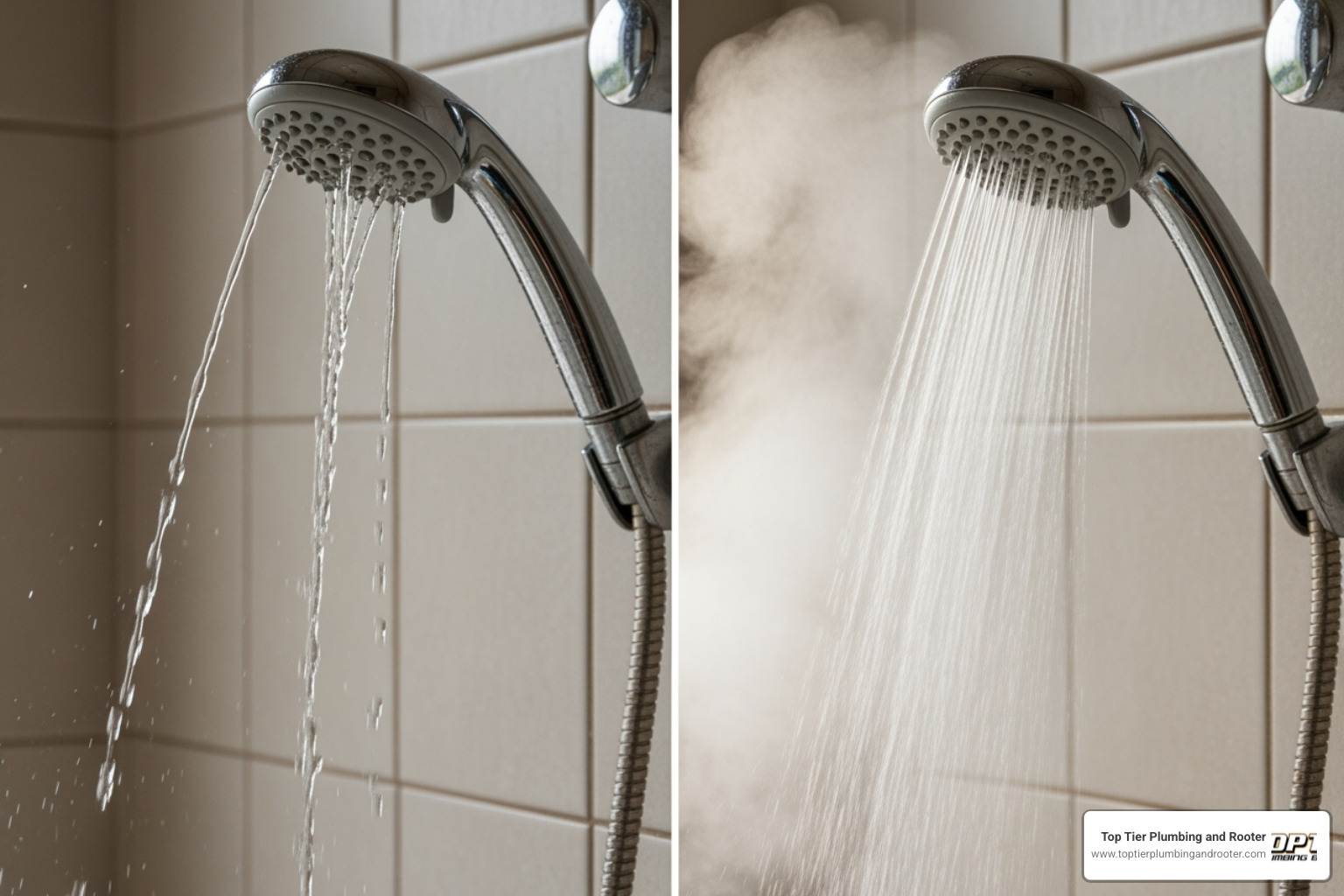
When you nail the sizing, your tankless water heater becomes the silent hero of your home—delivering exactly what you need, when you need it, without any drama. When you get it wrong? Well, let’s just say cold showers have a way of making themselves very memorable.
Benefits of a Perfectly Sized Unit
A correctly sized tankless water heater transforms your daily routine in the best possible way. Consistent, endless hot water becomes your new reality. No more timing your showers around the dishwasher cycle or rationing hot water between family members. Whether two people are showering while someone’s doing dishes, your properly sized unit handles it all without breaking a sweat.
The energy efficiency benefits are impressive too. Tankless heaters are already 24-34% more energy efficient than traditional tank models, but a correctly sized unit operates at peak performance. It heats water only when you need it, avoiding the wasteful standby losses that plague tank heaters. This efficiency translates directly into lower utility bills that you’ll appreciate month after month.
Perhaps most importantly, a well-sized unit enjoys a longer equipment lifespan. When your tankless water heater isn’t constantly struggling to meet impossible demands or cycling on and off unnecessarily, it can easily last 20 years or more with proper care. Speaking of care, regular maintenance is key to maximizing these benefits—check out our guide on Maintaining Your Tankless Water Heater: Tips for Longevity and Efficiency to keep your investment running smoothly.
Consequences of an Improperly Sized Unit
Getting your tankless water heater sizing wrong creates problems that range from annoying to expensive. Undersized units are the more common mistake, and they make their presence known immediately. You’ll experience lukewarm water during peak usage times—imagine trying to shower while someone’s running the dishwasher, only to get hit with water that’s barely warm enough to rinse with.
Even worse is the dreaded “cold water sandwich” effect. This happens when your undersized unit struggles to ignite quickly enough between water draws, sending you a surprise burst of cold water right in the middle of what should be a nice, hot shower. It’s not dangerous, but it’s definitely not the relaxing experience you signed up for.
An undersized unit also means you simply can’t run multiple fixtures simultaneously without sacrificing performance. This defeats one of the main advantages of going tankless in the first place. Plus, when your unit is constantly working overtime to try meeting impossible demands, it experiences premature wear that can significantly shorten its lifespan.
Oversized units create different problems. While you won’t run out of hot water, you’ll face higher upfront costs for capacity you’ll never actually use. Oversized units also suffer from short cycling—turning on and off frequently for small hot water draws. This constant cycling creates unnecessary wear on components and reduces the unit’s overall efficiency, meaning you’re not getting the energy savings you expected from your tankless investment.
The bottom line? Proper sizing isn’t just a nice-to-have—it’s essential for getting all the benefits that make tankless water heaters such a smart choice for homes in Riverside and San Bernardino counties.
Frequently Asked Questions about Tankless Water Heater Sizing
When homeowners start exploring tankless water heater sizing, they often have similar concerns and questions. Let’s tackle the most common ones we hear from families in Riverside and San Bernardino counties.
Can one tankless water heater supply a whole house?
Absolutely! A single, properly sized whole-home unit can handle most households’ hot water needs beautifully. The key word here is properly sized—which is exactly why we’ve walked through all those calculations together.
For most families, one well-chosen tankless water heater provides endless hot water throughout the entire home. However, if you live in a very large home or have exceptionally high demand (think multiple luxury rainfall showers running simultaneously), you might consider installing multiple units in parallel. This setup, called “cascading,” allows the units to work together like a tag team, ensuring even the most demanding hot water situations are handled without missing a beat.
The beauty of a single whole-home unit is its simplicity. One unit means one installation, one maintenance schedule, and one point of control for your home’s hot water system.
How does the number of people in my home affect sizing?
The number of people in your household directly impacts your potential peak hot water demand, but it’s not just about counting heads—it’s about understanding habits and timing.
More people typically means a higher likelihood of simultaneous hot water use. Picture this: two teenagers getting ready for school while mom runs the dishwasher and dad starts a load of laundry. That’s the kind of scenario that determines your tankless water heater sizing needs.
A single person might only need 0.5-2 GPM during their peak usage, while a busy household of 4-5 members could easily require 6-10 GPM during those busy morning or evening rushes. It’s not just the total number of people, but their routines and how they overlap that matters most.
Think about your family’s patterns. Do you all shower at the same time? Does someone always seem to start the dishes right when someone else hops in the shower? These real-life scenarios are what drive your sizing requirements.
What happens if my tankless water heater is too big?
While an oversized unit won’t leave you shivering in a cold shower, it does create some unnecessary headaches. You’ll pay more upfront for capacity you simply don’t need, which nobody wants.
The bigger issue is something called “short cycling.” An oversized unit tends to turn on and off frequently for small hot water draws—like when someone quickly rinses their hands or fills a coffee pot. This constant starting and stopping can lead to premature wear on components and less efficient operation than a correctly sized model.
Think of it like using a freight truck to pick up groceries. It’ll get the job done, but it’s overkill and not the most efficient use of resources. While an oversized tankless water heater won’t hurt your comfort, it doesn’t maximize your energy savings or the unit’s potential lifespan either.
The sweet spot is finding that perfect balance where your unit meets your peak demand efficiently without being unnecessarily large.
Your Local Sizing and Installation Experts
Getting your tankless water heater sizing right is truly the key to open uping all the amazing benefits these units offer. While the steps we’ve covered give you a solid foundation for understanding what you need, there’s something to be said for having a professional take a look at your specific situation.
Every home is unique. Your plumbing configuration, local groundwater temperatures, household habits, and even the quirks of your daily routine all play a role in determining the perfect tankless water heater for your family. What works beautifully for your neighbor might leave you shivering if your peak usage patterns are different.
That’s where professional consultation becomes invaluable. Our certified professionals at Top Tier Plumbing and Rooter have spent years mastering the ins and outs of tankless water heater sizing specifically for homes in Riverside and San Bernardino counties. We understand how our local climate affects groundwater temperatures throughout the year, and we’ve seen how different household sizes and lifestyles impact hot water demand.
When you work with our team, you’re not just getting someone who can crunch the GPM and temperature rise numbers. You’re getting experts who can spot potential installation challenges before they become expensive problems, recommend the right fuel type for your home’s setup, and help you steer the differences between condensing and non-condensing technology.
We’re here to make the entire process smooth and stress-free. From that initial assessment through flawless installation, we guarantee your system will be the perfect fit for endless, efficient hot water. Our team offers 24/7 availability, same-day service, and upfront pricing, all backed by our 100% satisfaction guarantee and commitment to quality work done right the first time.
Get expert help with your tankless water heater installation and experience the Top Tier difference. Should you ever need it down the road, we’re also here for all your Water Heater Repairs.


